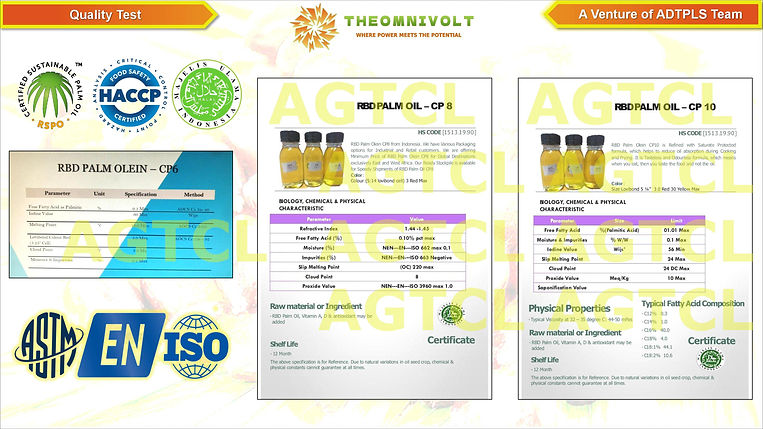
PALM OIL - CP 6/8/10
About Palm Oil
Palm oil is one of the world's most produced and consumed oils. This cheap, production-efficient and highly stable oil is used in a wide variety of food, cosmetic and hygiene products, and can be used as source for bio-fuel or biodiesel. Most palm oil is produced in Asia, Africa and South America because the trees require warm temperatures, sunshine and plenty of rain in order to maximize production.
Global palm oil production is dominated by Indonesia and Malaysia. These two countries, together, account for around 85 to 90 percent of total global palm oil production. Indonesia is the largest producer and exporter of palm oil worldwide.
Some common palm oil used in the food processing industry are in the form of margarine, vegetable ghee, used in products such as chocolate, bread, cookies, and cakes.. It is also commonly used for frying by fast food chains, as well as industrially manufactured products such as crisps and instant noodles. Most processed products, including products like infant formula, contain some amounts of added fat. This added fat is usually palm oil.
Palm oil is semi-solid at room temperature (20°C). The liquid portion could be physically separated from the solid portion of palm oil by fractionation. After fractionation the liquid portion is called “palm olein”, which is commonly bottled and sold as cooking oils. The solid fat portion is called “palm stearin” and it is commonly used to formulate trans-free fats.
A method used by the food industry to increase the firmness and spread ability of oils. Vegetable oils are normally unsaturated fats which are liquid at room temperature, when hydrogen atoms are added to these oils, they become semi-solid. Partial hydrogenation is where the fat molecule is only partially saturated with hydrogen, and this produces trans fats.
RBD Palm Olein CP10 has an iodine value of 56. Because of its fatty acid composition and good oxidative stability Palm Olein CP10 is excellent to be used as liquid cooking oil and more suitable for frying.
Apart from its high-quality performance, the added advantage is it does not alter the taste or flavor of fried food as it does not have any distinct fragrance. Moreover, it leaves the meal completely dry with no dripping of oil. It has a high solid fat content which reduces the need for hydrogenation.
Palm oil’s high oxidative stability also makes it less susceptible to becoming rancid, giving it a long shelf life. The length of time a food can be kept under stated storage conditions while maintaining its optimum safety and quality.
Malaysia Crude Palm Oil Daily Price
Specification RBD CP 10 Anti Oxidant (E319:E320)

Other Specifications

.png)
.png)


Certifications': Roundtable on Sustainable Palm Oil (RSPO) Certified | HALAL Certified | Hazard Analysis Critical Control Point (HACCP)
Packaging & Shipment
.png)
IBC Tank
1 Litre

Flexi-Bag

5 Litres

18 Litres

20 Litres
.png)
18 Litres Tin

25 Litres
.png)




Quality Standards
As per International Acceptance of Gas / Oil / Fuel, we strictly follow International Standards of ASTM - American Society for Testing and Materials / ENISO - European Union International Organization for Standardization.
Cargo Origin
Considering the current war situation, the Origin of the Cargo and the Vessel's Flag which will carry the Cargo for EN590 / Palm Oil will be from a Non-Sanctioned Country due to Restrictions imposed for Sanctioned Countries by USA / UN OFAC Department.

The Palm Oil will have following certifications
-
Roundtable on Sustainable Palm Oil (RSPO)
-
HALAL
-
Hazard Analysis Critical Control Point (HACCP)
Certifications
INCOTERM - FOB
For various commodoties, sales are on the Basis of FOB / CIF - Free On Board / Cost Insurance Freight as per INCOTERM 2020.
For PAL OIL the Sales are on FOB basis and BITUMEN / EN590 sales on CIF basis.


